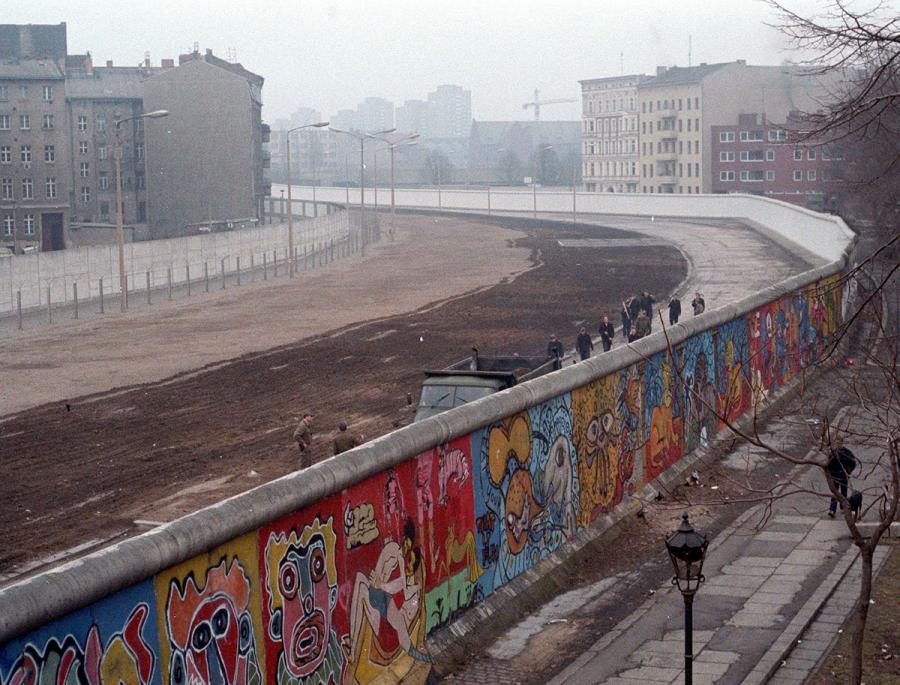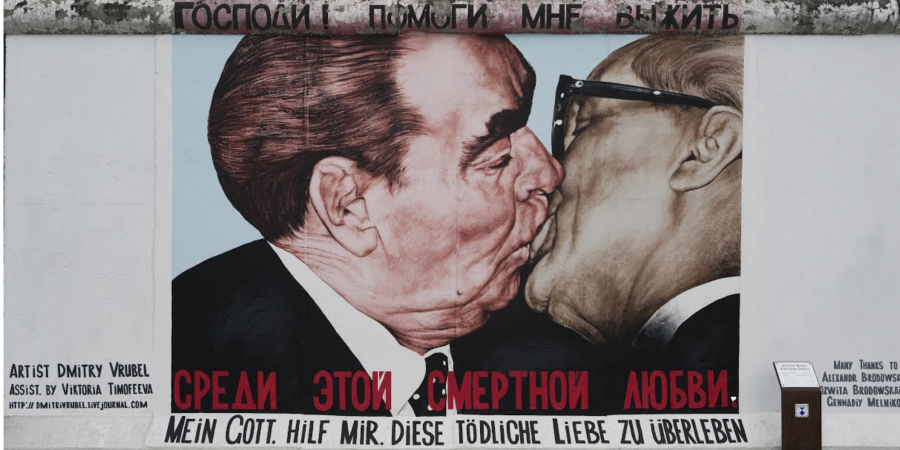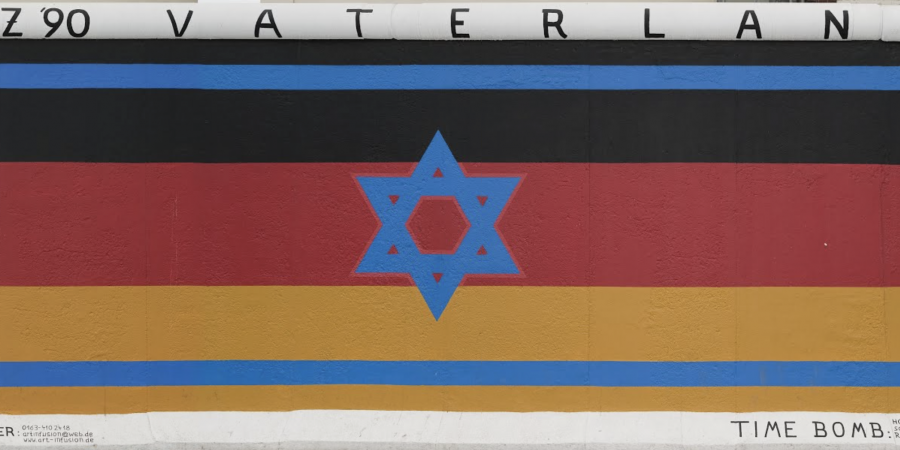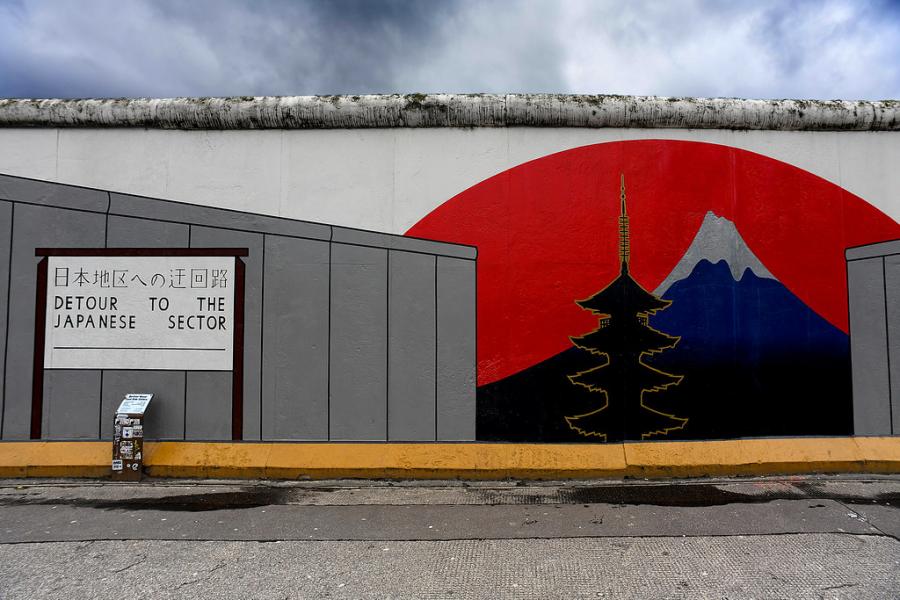
East Side Gallery - globalized monument in one of Europe's capitals
The East Side Gallery is a 1.3-kilometer-long section of the Berlin Wall located in Berlin, Germany along the river Spree. It is situated on the longest remaining part of the Berlin Wall and has been transformed into one of the world's largest open-air galleries, displaying over 100 artworks. As a popular tourist destination, the East Side Gallery attracts millions of visitors each year. It is open to the public and admission is free. In addition to the murals, the East Side Gallery is home to a number of cultural events and activities, including music performances and exhibitions.
The Gallery was created in 1990, shortly after the fall of the Berlin Wall, when artists from 21 different countries were invited to paint murals on the eastern side of the wall. They depict a variety of themes, including peace, freedom, and unity, challenging the viewers to reflect on the political landscape of the time. Many of the murals feature bright colors and bold designs, and they have become an iconic symbol of the city of Berlin. Furthermore, the East Side Gallery serves a role as a powerful reminder of the city's history and its role in the reunification of Germany and symbolizes the victory of capitalism over communism.
The essay argues for the position of the Berlin Wall, more specifically the East Side Gallery, as one of the symbols of fast-paced cultural mixing, that worked as a space for international artists dealing with local and global issues, focusing on the decades of division and war brought by the tensions between the East and the West. It uses the theory of Nederveen Pieterse and other scholars about globalization as well as data available from various internet sources.
Globalization in art
Globalization is a process that has been going on for millennia. Different civilizations have always traded material goods, ideas, art, and their respective cultures with each other. This process was slow and happened usually between a small number of states at once. However, the technological progress of the 20th century brought with it completely new ways of understanding what globalization is and how it really affects peoples of the world.
The East Side Gallery facilitates the trade of ideas, histories, feelings and human connections, all while being an important piece of history itself
Globalization “crosses the ideological spectrum and engages social movements and politics at all levels” (Nederveen Pieterse, 2009, p. 7). Art is one of them, bearing powerful, borderless, and engaging topics that can be interpreted in many different parts of the world. The East Side Gallery facilitates the trade of ideas, histories, feelings, and human connections, all while being an important piece of history itself. Its significance cannot be ignored, as it is “material evidence of the fight against oppression, as well as pieces of historical reference for generations too young to have lived through the duress imposed by the communist regime” (Alvim, 2015). The Berlin Wall will remain as such, providing a glimpse into the less-globalized past.

Figure 1: Berlin Wall in the 1980s, murals by Thierry Noir
Multiple scholars agree on the fact that the ongoing globalization in art has started to notably increase its pace in the 1980s (Tomlinson, 2003, p. 269; Dimova & Gillen, 2017, p. 61). It was a decade of not only major political change but also cultural, social, and technological. The collapse of the Soviet Union and the unification of Europe happened alongside the progress in communication and information technologies which impacted almost all areas of life.
It is home to not only the superficial elements of culture, but also deeper-lying issues of the contemporary society
Nederveen Pieterse (2009, p. 56) also argues that what is being mixed between cultures are only the ‘languages’ rather than ‘grammars’. This means that cultural trade consists only of the superficial elements of culture, like foods, costumes, and arts, while deeper attitudes and values remain largely untouched (Nederveen Pieterse, 2009, p. 56). In the case of East Side Gallery, this is not so accurate. The Berlin Wall is an important monument mostly for Germans, but also for other nationalities living in Berlin. It is home to not only the superficial elements of culture but also deeper-lying issues of contemporary society. It works as a common ground for people from Europe and other continents, giving a space for reflection to each person visiting the monument. Various artworks delve deep into the underlying issues and misunderstandings of the past in hopes to unite people and make them reflect on their own lives. In this instance, globalization heavily contributes to the relevance and reception of the East Side Gallery.
East Side Gallery and its significance
Berlin is a city where people can look for “a taste of the past and a vision of the future” (Alvim, 2015). The East Side Gallery is a globalized piece of history, it encapsulates various ideas and historical elements brought together in a series of murals in one of the biggest cities in Europe. For many years Berlin was a divided capital where people on one side lived freely, with access to Western products and media, while people on the other side were oppressed by a communist regime and not allowed to cross into the ‘better’ part of the city. This stopped being the case in 1989 when the wall dividing Berlin fell and the flow of people, products, and information was free again.
The curated murals of the East Side Gallery facilitate an important ground for international artists who had something to say about the political, social, and cultural landscapes of the decades of division and exclusion. It is where contemporary art meets political activism (Dimova & Gillen, 2017, p. 60), and all of that happens on a relic of the past that still holds immense value to great numbers of people. Although the Gallery hosts murals painted by artists hailing from over 20 countries, it works very much in a local context. Most of the artworks feature symbols that immediately point to the history of Berlin, communism, and the years of oppression that would have not happened if not for the Berlin Wall.
The Gallery tells a unique story to every person visiting it
Murals on the East Side Gallery synthesize “the physical appearance of a site, its history and the artistic intervention” (Yan et al., 2019, p .76). They allow us to grasp the history of not only Berlin but also countries of the Eastern Bloc and Europe in its entirety. The East Side Gallery inherently focuses on common goals. There are “no fixed identities and no ‘authentic’ cultures” when talking about globalization in art (Dimova & Gillen, 2017, p. 60). The Gallery tells a unique story to every person visiting it. Since the art on the wall was made by international artists, visitors can experience each artwork personally and connect it to their own lives. Each mural tells a story that can be seen differently by people of different backgrounds. Each artwork has multiple ways somebody could interpret its meaning. Thus, although the murals are fixed in space and time, they make it possible to have a very personal experience while visiting the monument.
Art of the Berlin Wall
The following section aims to explain the history and meaning behind some of the most notable murals of the East Side Gallery. It would be impossible to talk about all 100 artworks, so only three are chosen.
My God, Help Me to Survive This Deadly Love, often referred to as the Fraternal Kiss is one of the most recognizable artworks from the East Side Gallery. Painted by Russian artist Dmitri Vrubel, it depicts a kiss between East German president Erich Honecker and Soviet leader Leonid Brezhnev. It is based on a photo taken in 1979 and provides a clever and satirical response to the politics of the time. East Germany and the Soviet Union were closely connected for decades in the 20th century, which was further immortalized through this mural.
By showing the leaders in a romantic embrace, the mural satirizes the official propaganda and rhetoric that emphasized the brotherly relations between the two countries. It subverts the traditional depiction of powerful men as harsh and unemotional by portraying them in a vulnerable and intimate moment. It captures the absurdity of the political situation and a historical moment when the old political order was crumbling, and a new one was about to begin.

Figure 2: My God Help Me Survive This Deadly Love
The second mural, a much more controversial one, is Vaterland. It features a German flag, with elements of the Israeli flag placed over it. Made by Gunther Schaefer, it was created to honor the Night of the Broken Glass, an event that was one of the first acts of terror against Jewish people in Nazi Germany during the 1930s. Although the mural was painted with good intentions to show unity in the fight for human rights and against the oppressive Nazi regime of the past, people were displeased by it, vandalizing the work multiple times throughout its history (Dundon, 2017). Vaterland seeks a connection between the two modern nations that have a very troubled past.
The use of the German flag, with elements of the Israeli flag overlaid, symbolizes the connection between the troubled past of Germany during the Nazi era and the creation of the state of Israel as a homeland for Jewish people after the Holocaust. It also represents the idea of reconciliation and unity between the two nations, despite their complex history.
The Night of the Broken Glass was an attack against Jews in Nazi Germany and Austria in November 1938, during which synagogues, Jewish-owned businesses, and homes were vandalized, looted, and destroyed. The use of elements from the Israeli flag symbolizes the resilience and strength of the Jewish people in the face of persecution, and the creation of the state of Israel as a response to the horrors of the Holocaust.

Figure 3: Vaterland
Detour to the Japanese Sector, on the other hand, is a more positive and hopeful depiction of a world inaccessible to a greater population of East Germany and other communist countries of the 20th century. Thomas Klingenstein, its author, wanted to portray his childhood dreams of exploring Japan, a country that he could not travel to and even learn too much about (Dundon, 2017). Japan, similarly to many other countries outside the communist regime, was behind a wall almost unpassable by East German citizens. After the collapse of the Berlin Wall, brand-new travel possibilities sprouted and the flow of people was not nearly as heavily restricted as before.
Detour to the Japanese Sector is a metaphorical representation of the cultural and political divide between East and West during the Cold War era. It seems to offer a glimpse of the world beyond the walls and barriers, giving hope and inspiration to those who were previously unable to explore and learn about other cultures. It is remarkable how the fall of the Berlin Wall has opened up new opportunities for travel and cultural exchange, allowing people to connect and learn from each other in ways that were not possible before.

Figure 4: Detour to the Japanese Sector
Unfortunately, the original murals did not receive proper protective treatment that would prevent them from deteriorating over the years. In the decades following the establishment of the East Side Gallery, nearly all of the artworks faded from existence, needless to say that many of them were also vandalized in one way or another. That is why multiple restoration efforts were undertaken to preserve the murals.
Today they are well-maintained and are not getting as vandalized as before, but being an open-air gallery, they will still be targeted by people’s markers and spray cans. Despite the fact that this remaining piece of the Berlin Wall is an important landmark to the city and is being treated with respect by the authorities, not all of the artworks remain. A 20-meter portion of the wall was scheduled to be removed in 2013 in order to build a luxury apartment building (Connolly, 2013). This sparked protests and agitated Berliners who wanted to keep the integrity of the wall, but they were unsuccessful and the fragment of the wall was torn down in the end.
The legacy
Berlin Wall’s importance is further emphasized by its international legacy. Some of the pieces of the original wall that have been torn down were gifted to important individuals and institutions around the world. Among the institutions honored with pieces of the wall are the United Nations’ headquarters in New York City and the European Commission’s headquarters in Brussels (Grither, 2021). One lucky individual who received his share was Bill Gates. A 3.5-ton piece was gifted to him by Daimler-Benz AG in 1996 (Updike, 1996).
Figure 5: Piece of the wall gifted to Bill Gates
Wrapping up
Taking everything into consideration, the East Side Gallery is a space that facilitates the international trade of art, ideas, and activism. It is a tremendously important piece of history, that has been preserved and augmented to meet the needs of the globalized art world. Being located in one of Europe’s most important capital cities, it gives a glimpse into the past, a space for reflection, and connects people from all over the world. Tourists and visitors can look at the numerous artworks and experience each of them in their own, personalized way. Murals of the East Side Gallery are vital to the city of Berlin and the post-communist countries of Europe that share similar histories.
Globalization has led to East Side Gallery being a highly valued monument all around the world. Millions of visitors want to experience it for themselves to see the years of government oppression and what divided this major European city. These murals represent political activism, societal issues, and themes like freedom and unity that could finally sprout after the fall of the wall. The artists who took part in the creation of the East Side Gallery came from many different countries and backgrounds and yet made something coherent that many people can relate to no matter their origins. Overall, the East Side Gallery is a major product of globalization and its processes, but also a contributor to the globalization discourse worldwide.
References
Alvim, J. (2015, April 1). Resistance art, or the art of resisting: 25 years of the East Side Gallery. Contributoria.
Dimova, D., & Gillen, E. J. (2017). Globalization and Cultural Identity – The Perspective of Contemporary Art. Trilogue Salzburg.
Dundon, A. (2017, November 20). Iconic Murals on the Berlin Wall. Culture Trip.
Nederveen Pieterse, J. (2009). Globalization and Culture: Global Mélange (2nd ed.). Rowman & Littlefield Publishers.
Tomlinson, J. (2003). Globalization and Cultural Identity. In D. Held (Ed.), The Global Transformations Reader: An Introduction to the Globalization Debate (pp. 269-277). Cambridge.
Updike, R. (1996, August 12). Microsoft’s Wall Can Be Viewed On The Web. The Seattle Times.
Yan, L., Xu, J. B., Sun, Z., & Xu, Y. (2019). Street art as alternative attractions: A case of the East Side Gallery. Tourism Management Perspectives, 29, (pp. 76–85).